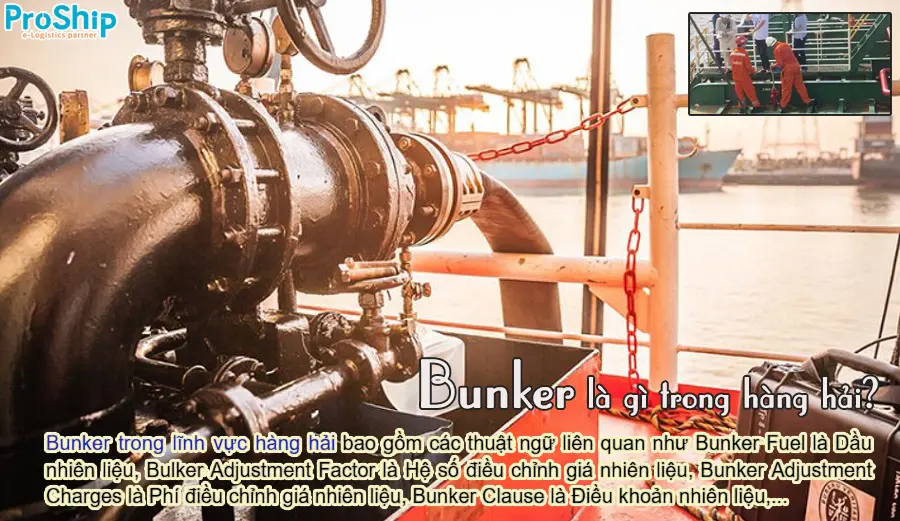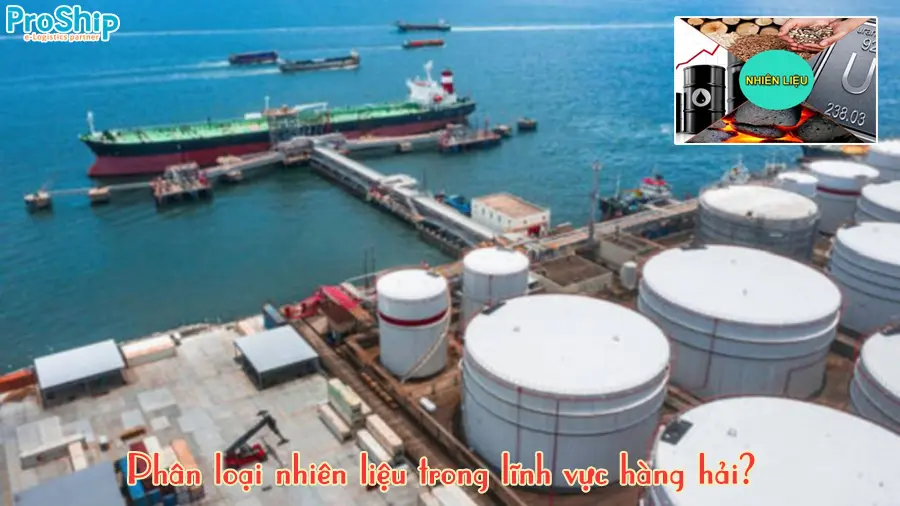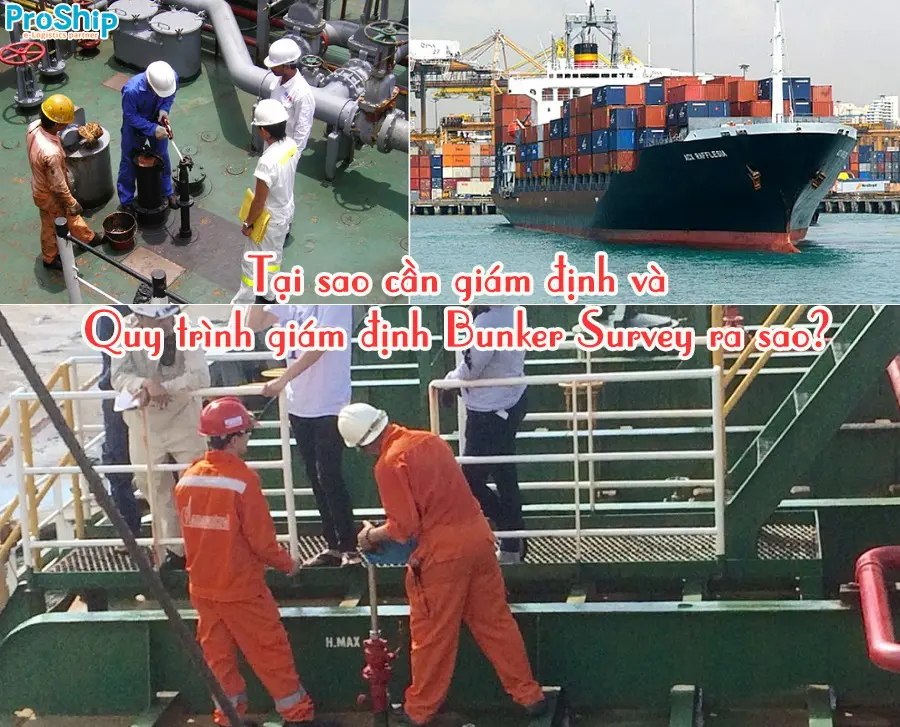x Private, businesses, organizations, shippers, ... are participating in the field of maritime, shipping, want to learn more deeply what is the term Bunker?
X You want to know what bunker in navigation is understood in? How to classify fuel in the maritime sector?
X You want to learn more about the reasons and process of making fuel inspection on board?
In the following content, Proship.vn we will answer what Bunker is in the maritime field in the most detailed way. At the same time, those who have been participating in the field of maritime, shipping also know why they have to assess fuel on board, ... and other useful knowledge about Bunker.
What does the term Bunker in maritime mean?
Want to know what Bunker is? container shipping unit , learn through some terms related to Bunker used quite commonly in the maritime field, including:
Bunker Fuel - Fuel oil
Bunker Fuel - Fuel oil is the term commonly used in maritime. "Fuel" is known as the noun fuel. "Bunker" acts as a noun, and acts as a verb in English. The nouns that means the coal store, the coal container (on the ship), when used as a verb, it means adding, pouring into fuel.
The phrase "Bunker Fuel" is used to even even if any fuel oil is used as a fuel on the ship that is commonly used in the coal period used as a fuel and the ship at that time is still running on coal.
Bulker Adjustment Factor (BAF) - Fuel price adjustment coefficient
Bulker Adjustment Factor - Fuel price adjustment coefficient is the percentage that the ship owner announced as a basis for calculating fuel price adjustment fee, when fuel used for ships for abnormal prices at some point. This surcharges are called fuel surcharge.

Bunker Adjustment Charges (BAC) - Fuel price adjustment fee
Bunker Adjustment Charges - The fuel price adjustment fee is the amount of surcharges that tenants must pay more to the ship owner outside the original charter of the published of the marketer or container shipping company, when used for the ship for abnormal prices at some point.
Bunker Clause - Fuel Terms
Bunker Clause - The term of fuel in the rental contract stipulates that the tenant will accept and pay the remaining fuel in the ship's tank at the ship port and the ship owner will accept and pay the remaining fuel in the tank at the ship's refund port at the fuel price at those places. The maximum and minimum level of this amount will be prescribed by the two parties.
Fuel classification in the field of maritime
What terms related to Bunker are listed above. Next, let's explore how the fuel in navigation is classified:
Fuel classification by physical state
According to the physical state, the fuel is classified into:
Solid fuel
Are things found in the wild firmly, such as wood, coal or peat. Wood is widely used in heating houses and industries as well as in wood stoves. Peat, like wood, used in heating.
Fuel
Are substances in gas state and liquefied for storage. Among them: natural gas, butane gas and liquefied gas.
Liquid fuel
Are substances in liquid state, almost always at room temperature, although they can be at very low temperatures like liquid hydrogen. In it is: gasoline, kerosene, diesel oil, ethanol and liquid hydrogen and a few other types.

Fuel classification by origin and ingredients
According to the origin and ingredients, the fuels are classified into:
Fossil fuel
Are things of natural origin from the organic decomposition of animal and plant fossils, transforming and settling over centuries, such as oil, gas and coal:
- Coal:
Coal is a form of fossil fuel, formed from buried plants through stages from peat to brown coal, semi -bitumen coal, complete bitumen coal and finally coal.
- Natural gas:
Natural gas or natural gas is a mixture of burnt gases, coal and oil, natural gas is a fossil fuel commonly found together with oil fields in the earth's crust.
- Oil:
Petroleum/crude oil is a solid brown or green liquid, oil exists only in rock layers in some places in the Earth's crust. The oil after recovery by oil drilling is dead and separate into gasoline, kerosene to asphalt and reagent chemicals to produce plastic and pharmaceuticals.
Nuclear fuel
Uranium or uranium is a white metal chemical element belonging to the Actini group. This type of fuel is mainly used as fuel for nuclear power plants.
Biofuel
They are substances derived from the vegetable kingdom. Adding "biological" prefix indicates that the fuel may regenerate. The diversity of biofuel is classified according to the physical state of solids, liquids and gases.
Should read: Get good cold container transportation
Why do you need to assess and the Bunker Survey assessment process?
Let's find out why the inspection on the Bunker Survey train and the steps to perform the assessment:
Reasons for fuel assessment on board
In shipping, ship owners, ship operators, charterers, ... always need to assess the amount of fuel on the train at a certain time/location to:
- Control fuel consumption of the ship (for management purposes);
- Carry out the delivery of the ship (when the chartering expiration or when the ship is started);
- Check the amount of oil received into the ship (control the purchase of fuel), ...

Fuel inspection process on board
Steps to conduct assessment on Bunker Survey:
- Step 1: Check the status of the ship and collect information (determine the trim, list, the status of loading/loading, receiving oil, ... The layout of fuel tanks, refer to the proportion of fuel types - fuel consumption for each operating state of the ship, ...);
- Step 2: Conduct measurement of fuel tanks on cargo boats (measuring souding/ullage and temperature);
- Step 3: Calculate the amount of fuel on the ship at the time of assessment;
- Step 4: Make reports and release assessment certificates.
What is Bunker and the knowledge that needs to be known about fuel classification, the process of fuel inspection on board has been shared in the most detailed and complete way ... Any questions about the term used in shipping, maritime, contact 0909 344 247 for answers and advice on multimodal package service that you are interested in at Proship Logistics.
